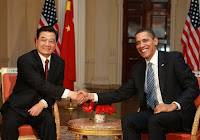 On November 24, 2009, the California Air Resources Board (CARB) released a Preliminary Draft Regulation (PRR) outlining the details of how cap and trade program for global warming pollution may be designed. CARB is seeking comments on the PDR by January 11 and will hold a public workshop in Sacramento on December 14.
On November 24, 2009, the California Air Resources Board (CARB) released a Preliminary Draft Regulation (PRR) outlining the details of how cap and trade program for global warming pollution may be designed. CARB is seeking comments on the PDR by January 11 and will hold a public workshop in Sacramento on December 14.The Preliminary Draft Cap and Trade Regulation (PDR) basically lays out most the details of the cap and trade program. For the first time, the PDR establishes an official limit on offsets: 49% of reductions from 2012-2020. Unfortunately, this amount of offsets is so large that the big polluters who are capped may not have to make ANY emission reductions until 2020.
CARB has never held a public workshop on setting an offset limit. CARB recently stated that the Economic and Allowance Advisory Committee will not be doing any work on offsets. CARB will not be doing any economic modeling on various offset limits and their related co-pollutant reduction benefits (as the Board resolution required). The PDR provides no rationale or basis for deciding on a 49% limit.
CARB has proposed that the offset limit be set at 49% of the cumulative annual reductions below the level of emissions in 2012.* According to CARB data included with the PRD, we show graphically below that this large amount of offsets could delay emission reductions in the capped sectors (electricity, transportation fuels, and large industrial sources) until 2017 or later, depending on how the compliance periods are structured.
 Many have been confused about how CARB calculates this 49%. Here’s how they do it: CARB estimates that in 2012, the capped sectors in California will emit roughly 433 million metric tons of global warming pollution. Each year, the cap is lowered slightly, resulting in emission reductions. Each year, the emission reduction relative to 2012 gets larger and larger, even though year-to-year it’s the same. For instance, each year from 2016-2020 the annual reduction relative to the emission level from the year before is 11 MMT. However, in 2020, the emission reduction relative to 2012 is 68MMT. CARB has chosen to calculate the offset limit based on the cumulative annual reductions relative to 2012 (249 MMT), instead of the cumulative total of actual reductions occurring each year (64 MMT). Offsets will be doled out across three compliance periods, but un-used offsets from one compliance period will be returned to a general “pool” or may be banked for later use.
Many have been confused about how CARB calculates this 49%. Here’s how they do it: CARB estimates that in 2012, the capped sectors in California will emit roughly 433 million metric tons of global warming pollution. Each year, the cap is lowered slightly, resulting in emission reductions. Each year, the emission reduction relative to 2012 gets larger and larger, even though year-to-year it’s the same. For instance, each year from 2016-2020 the annual reduction relative to the emission level from the year before is 11 MMT. However, in 2020, the emission reduction relative to 2012 is 68MMT. CARB has chosen to calculate the offset limit based on the cumulative annual reductions relative to 2012 (249 MMT), instead of the cumulative total of actual reductions occurring each year (64 MMT). Offsets will be doled out across three compliance periods, but un-used offsets from one compliance period will be returned to a general “pool” or may be banked for later use.Details on the Dec 14th meeting
Copy of the Preliminary Draft Regulation
The offset limit is described (cryptically,as 4% of total emissions--which is the same thing at 49% of reductions-- on p. 42). Offset quality parameters are described on pp. 60-84. Note--CARB suggests that it will accept a limited amount of CDM credits (p. 79) (Source: Erin Rogers)











 Video of Tunnel Line
Video of Tunnel Line


































